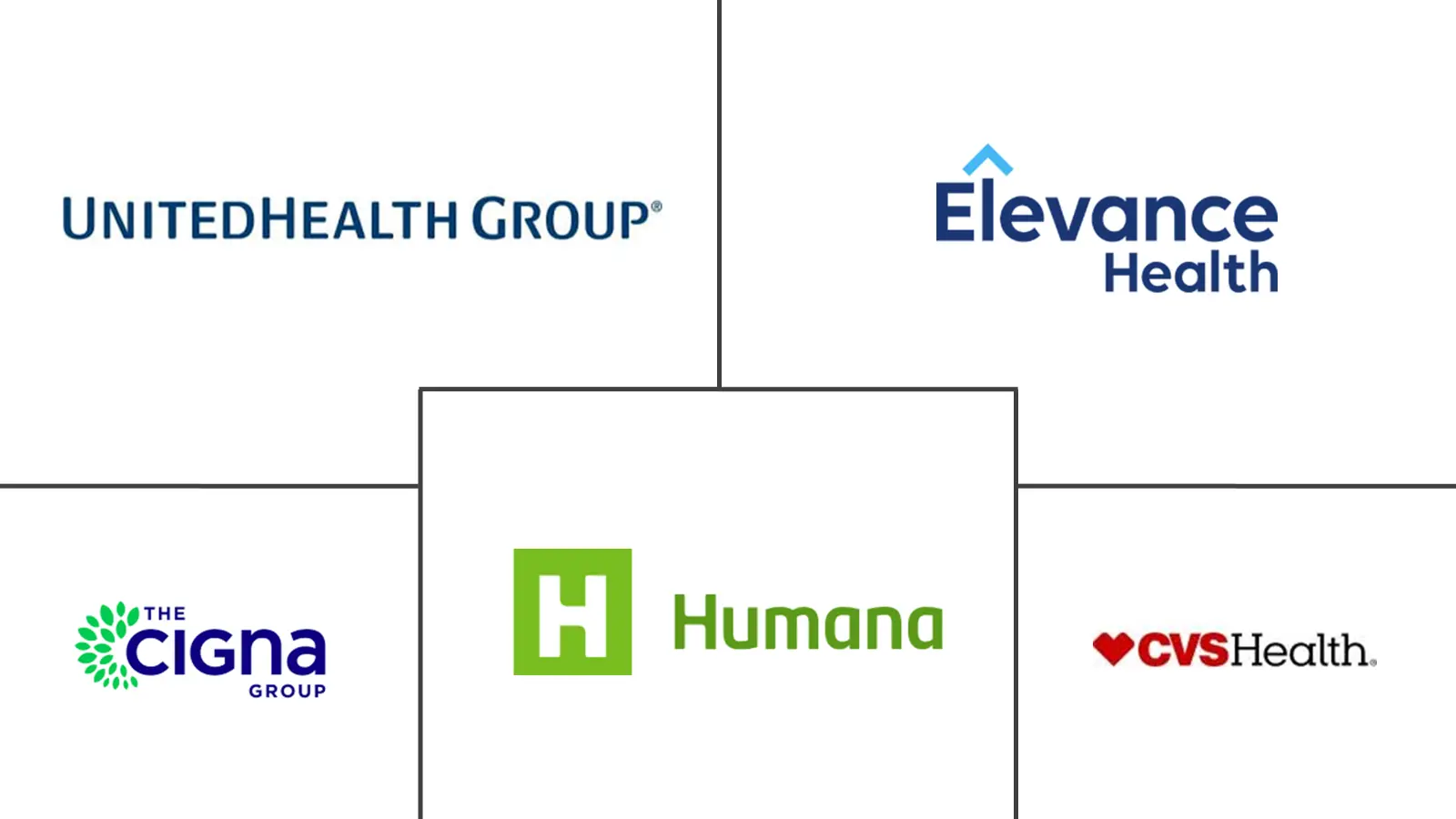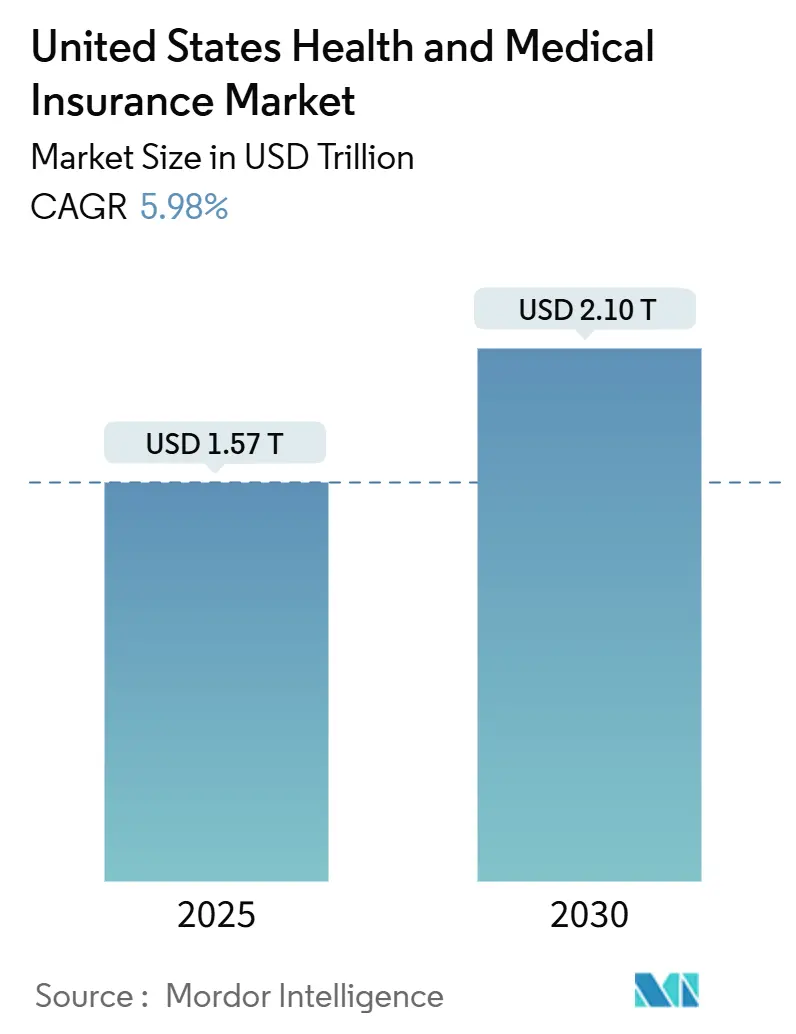
United States Health And Medical Insurance Market Analysis by Mordor Intelligence
The United States health and medical insurance market reached USD 1.57 trillion in 2025 and is projected to advance to USD 2.1 trillion by 2030, reflecting a 5.98% CAGR and underscoring continued demand despite regulatory flux. An aging population powers expansion, higher chronic-disease prevalence, richer ACA subsidies, and brisk Medicare Advantage enrollment gains that collectively widen the covered population and support premium growth. Employer plan resiliency, the fast take-up of high-deductible options, and digital distribution also contribute to the positive trajectory, while carrier investment in value-based care and AI-driven underwriting improves product differentiation and cost control. Insurer consolidation continues as firms seek scale to navigate medical loss ratio pressure and unlock national reach, illustrated by recent asset purchases in the Medicare segment. Regional public-option pilots and reinsurance programs further stabilize premiums and stimulate competition, especially in the West.
Key Report Takeaways
• By coverage type, employer-sponsored insurance led with 47.5% of the United States health and medical insurance market share in 2024, while Medicare Advantage is forecast to expand at a 7.80 % CAGR to 2030.
• By plan type, PPOs commanded 46% revenue share in 2024; high-deductible health plans are projected to grow fastest at 9.45% CAGR through 2030.
• By insurance type, comprehensive major-medical coverage accounted for 85.67% share of the United States health and medical insurance market size in 2024, whereas ancillary lines such as accident and critical-illness coverage are set to climb at a 10.31% CAGR through 2030.
• By distribution channel, brokers and agents held a 55.24% share in 2024, yet online exchanges post the highest projected CAGR at 12.00% to 2030.
• By region, the South captured 35.34% of 2024 premiums, but the West is poised for the fastest 6.40% CAGR through 2030.
United States Health And Medical Insurance Market Trends and Insights
Drivers Impact Analysis
| Driver | ( ~ ) % Impact on CAGR Forecast | Geographic Relevance | Impact Timeline |
|---|---|---|---|
| Rising healthcare costs & aging population | +1.8% | Global | Long term (≥ 4 years) |
| Expansion of ACA subsidies & Marketplace enrollment | +1.2% | National; non-expansion states | Medium term (2–4 years) |
| Growth in Medicaid managed care adoption by states | +0.9% | Southeast & Midwest | Medium term (2–4 years) |
| Employer ICHRAs & QSEHRAs shifting coverage | +0.6% | National; tech & professional services | Long term (≥ 4 years) |
| AI-driven risk stratification | +0.4% | Major metros | Short term (≤ 2 years) |
| Telehealth reimbursement parity | +0.3% | Rural emphasis | Short term (≤ 2 years) |
| Source: Mordor Intelligence | |||
Rising Healthcare Costs & Aging Population
Premium growth remains closely linked to rising medical prices and higher utilization among seniors, with large-group medical loss ratios climbing above 90% before edging down in 2023. Medicare Advantage enrollment added 5.4% new members in 2024, yet elevated specialty-drug spend and chronic-disease incidence strained margins, pushing carriers toward intensified risk-management and value-based arrangements [1]Healthcare Finance News Staff, “ACA Enrollment Hits Record 24 Million,” healthcarefinancenews.com. Employer surveys show 76% of firms worried about specialty-pharmacy costs, spurring interest in site-of-care steering and biosimilar adoption. Demographic momentum, therefore, both enlarges the addressable pool and challenges carriers to curb the trend through analytics, care coordination, and benefit redesign.
Expansion of ACA Subsidies & Marketplace Enrollment
Extended Inflation Reduction Act subsidies generated the highest ACA enrollment on record, with 24 million lives covered in 2025 and average household savings of USD 800 per year. The addition of DACA recipients in late 2024 further broadened the risk pool, while state-based marketplaces layered extra incentives that deepened retention and improved affordability. Although subsidies run through 2025, political uncertainty over renewal clouds long-range pricing, prompting some insurers to temper geographic expansion. Even so, stabilized enrollment underpins predictable claims experience and encourages digital outreach that lowers acquisition costs.
Growth in Medicaid Managed Care Adoption by States
Following the public-health-emergency unwind, states pushed harder toward managed care contracts that address social determinants and reward outcomes, bringing nearly all new enrollees under capitated arrangements [2]Joan Alker, “Medicaid Managed Care Expansion,” Georgetown University Health Policy Institute, georgetown.edu. Integrated D-SNP platforms give carriers new revenue streams by synchronizing Medicare and Medicaid funds, while contract language increasingly embeds health-equity metrics and in-home services. Penetration disparities across states preserve entry opportunities for specialized plans adept at rural engagement or complex-needs management, supporting above-average growth in the Southeast and selected Midwestern states.
Employer ICHRAs & QSEHRAs Shifting Coverage to Individual Market
Individual Coverage HRAs offer fixed allowances that employees apply to marketplace plans, delivering predictable employer expense and broad plan choice that boosts satisfaction, per early adopters in professional services and tech sectors. Adoption remains in early stages but is scaling as platforms simplify compliance and enrollment, potentially re-routing a meaningful slice of group lives into the individual exchange by decade-end. Insurers are adapting with portable network designs and concierge navigation to preserve experience and control risk.
Restraints Impact Analysis
| Restraint | ( ~ ) % Impact on CAGR Forecast | Geographic Relevance | Impact Timeline |
|---|---|---|---|
| Regulatory uncertainty around ACA subsidy extension | -0.8% | Marketplace-dependent states | Short term (≤ 2 years) |
| Rising medical loss ratios squeezing margins | -1.1% | National; Medicare Advantage & individual | Medium term (2–4 years) |
| State-level public-option initiatives intensifying price competition | -0.5% | State-level, concentrated in Colorado, Washington, Nevada | Medium term (2-4 years) |
| Escalating cybersecurity & data-privacy compliance costs | -0.4% | National, with higher impact on smaller insurers | Long term (≥ 4 years) |
| Source: Mordor Intelligence | |||
Regulatory Uncertainty Around ACA Subsidy Extension
The 2025 expiry of enhanced premium credits injects pricing ambiguity, leading some carriers to file conservative 2026 rates or limit new-state entry. Possible premium spikes could erode enrollment among middle-income households lacking employer benefits, destabilizing risk pools and amplifying adverse selection. State-based marketplaces with their subsidies mitigate volatility, giving participating insurers more predictable membership and revenue streams. However, in states relying solely on federal subsidies, the lack of additional support may drive sharper premium increases. This disparity could widen coverage gaps across regions and place added strain on federally facilitated exchanges.
Rising Medical Loss Ratios Squeezing Insurer Margins
Medical inflation and utilization upticks pushed Medicare Advantage loss ratios up almost 3 points in 2024, while Part D ratios rose more than 10% after regulatory changes. Carriers responded with narrower networks, prior-authorization tightening, and value-based specialist contracts, yet near-term earnings remain pressured. Government-program payment caps restrict pricing flexibility, so insurers must lean on analytics, telehealth triage, and home-based chronic-care programs to contain cost growth. Rising pharmacy benefit costs and specialty drug usage further strain margins, especially under the new inflation rebate provisions. As a result, some smaller plans may exit less profitable counties or consolidate operations to preserve financial viability.
Segment Analysis
By Coverage Type: Employer Plans Anchor Market Despite Medicare Advantage Surge
Employer-sponsored coverage retained 47.5% of the United States health and medical insurance market in 2024, ensuring a large risk pool that stabilizes premium growth. Medicare Advantage, however, is outpacing all other lines with a 7.80% CAGR, fueled by baby-boomer aging and zero-premium plan marketing. Subsidized ACA coverage also expands as enhanced credits persist, while Medicaid managed care keeps rising in states chasing budget predictability. Military and federal-employee programs remain steady yet slow-growing.
Employers increasingly deploy high-deductible designs, account-based funding, and digital navigation to restrain premium hikes, whereas Medicare Advantage carriers add dental, vision, and OTC allowances that appeal to seniors seeking holistic benefits. ICHRAs may migrate some workers to individual coverage, but group plans still dominate because of tax advantages and turnkey administration. Regulatory payment adjustments and star-rating thresholds create operational headwinds for Medicare Advantage participants, pushing them toward care-coordination investments that sustain margins.
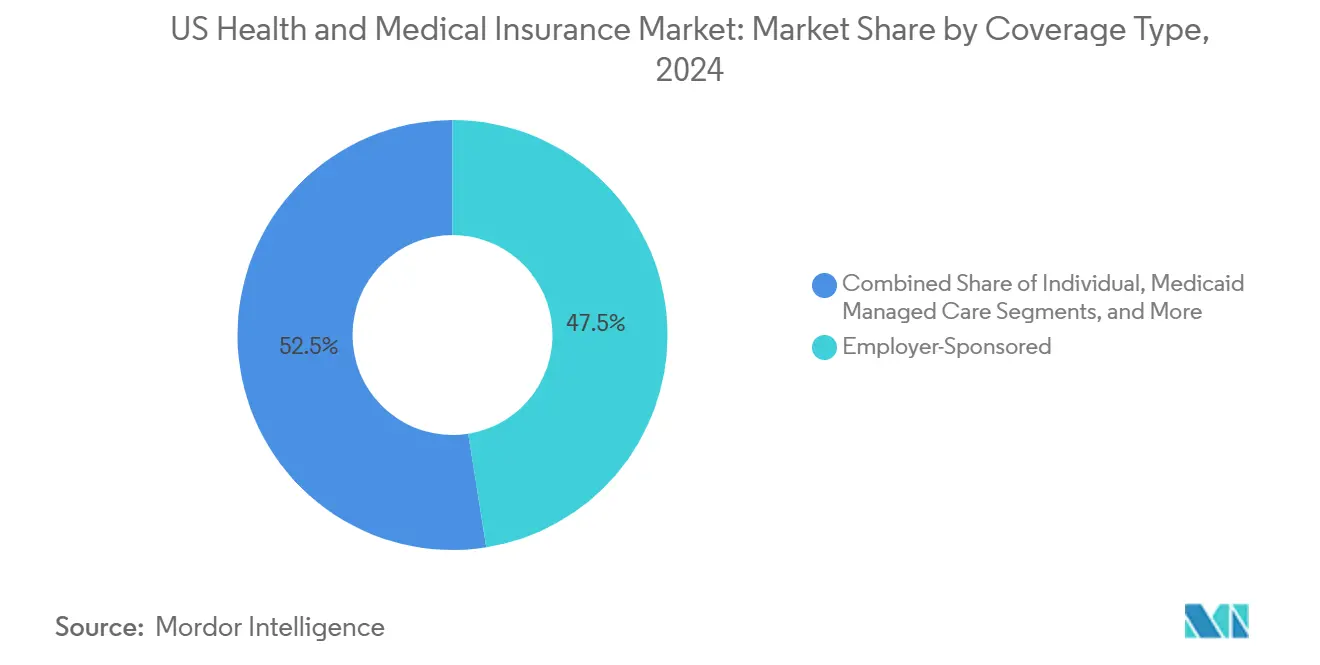
Note: Segment shares of all individual segments available upon report purchase
By Plan Type: Consumer Cost Sensitivity Reshapes Benefit Architecture
Preferred Provider Organization (PPO) contracts retained 46% of 2024 written premium, securing the largest slice of the United States health and medical insurance market despite incremental share leakage to more consumer-directed formats. PPO durability reflects members’ desire for broad network access and straightforward out-of-network options, qualities valued by multi-state employers that need uniform benefit design. Insurers have refreshed PPO offerings with telehealth-first primary-care models, steerage incentives to value-based hospitals, and AI-enabled price-transparency tools that surface episode-level cost before treatment, which helps blunt criticism that PPOs lack spending discipline. Digital navigation layers comprising chatbots, provider-quality scores, and deductible trackers now accompany most large-group PPO contracts, improving member engagement and moderating unnecessary specialist visits.
High-deductible health plans (HDHPs) post the fastest 9.45% CAGR as employers pair them with employer-seeded health savings accounts to lower premium outlays without shrinking actuarial value [4]National Center for Health Statistics, “Health Insurance Coverage: Early Release 2024,” nchs.nih.gov. Yet the proportion of workers in HDHPs slipped to 41.7% in 2023 as some firms reversed course after noticing delayed preventive care and heightened employee turnover. To preserve momentum, carriers are embedding first-dollar coverage for virtual urgent care, diabetes supplies, and mental-health coaching while maintaining federal HSA compliance. Health Maintenance Organization and Exclusive Provider Organization products retain niche relevance among cost-sensitive small businesses and in regions where integrated delivery systems supply seamless care pathways, and Point-of-Service plans occupy a modest foothold for employers wanting a gatekeeper structure without strict referrals. Collectively, the segmentation shows an active recalibration toward affordability, price clarity, and network efficiency rather than a wholesale abandonment of legacy plan archetypes.
By Insurance Type: Comprehensive Core Augmented by Targeted Protection
Comprehensive major-medical contracts represented 85.67% of the 2024 premium, confirming their status as the bedrock of United States risk pooling and regulatory compliance with essential-benefit mandates. The dominance is reinforced by employer tax advantages and the ACA individual-mandate framework that still influences minimum coverage expectations in many large-group collective bargaining agreements. Insurers differentiate through chronic-condition management add-ons, integrated pharmacy-benefit oversight, and behavioral-health networks that shorten appointment wait times, which is an emerging purchase criterion for younger workforces. Many comprehensive products also bundle lifestyle coaching and digital therapeutics, which employers now view as cost-offsetting investments rather than fringe perks.
Ancillary accident, critical-illness, and hospital-indemnity policies advance at a 10.31% CAGR as firms seek benefit diversity without materially lifting fixed premium budgets. These lines fill perceived gaps that high-deductible enrollees face, offering lump-sum cash for unplanned events and thereby de-risking out-of-pocket volatility. Insurers cross-sell dental and vision riders to achieve administrative savings through single-card issuance and consolidated call-center support. Medicare Supplement plans stay stable among fee-for-service beneficiaries who value provider freedom, though steady migration to Medicare Advantage limits upside. Short-term medical remains tightly regulated on duration caps, so growth is subdued outside bridge coverage for mid-career job switchers. Overall, product stratification illustrates how carriers mesh broad protection with precision bolt-ons tailored to evolving household liquidity concerns.
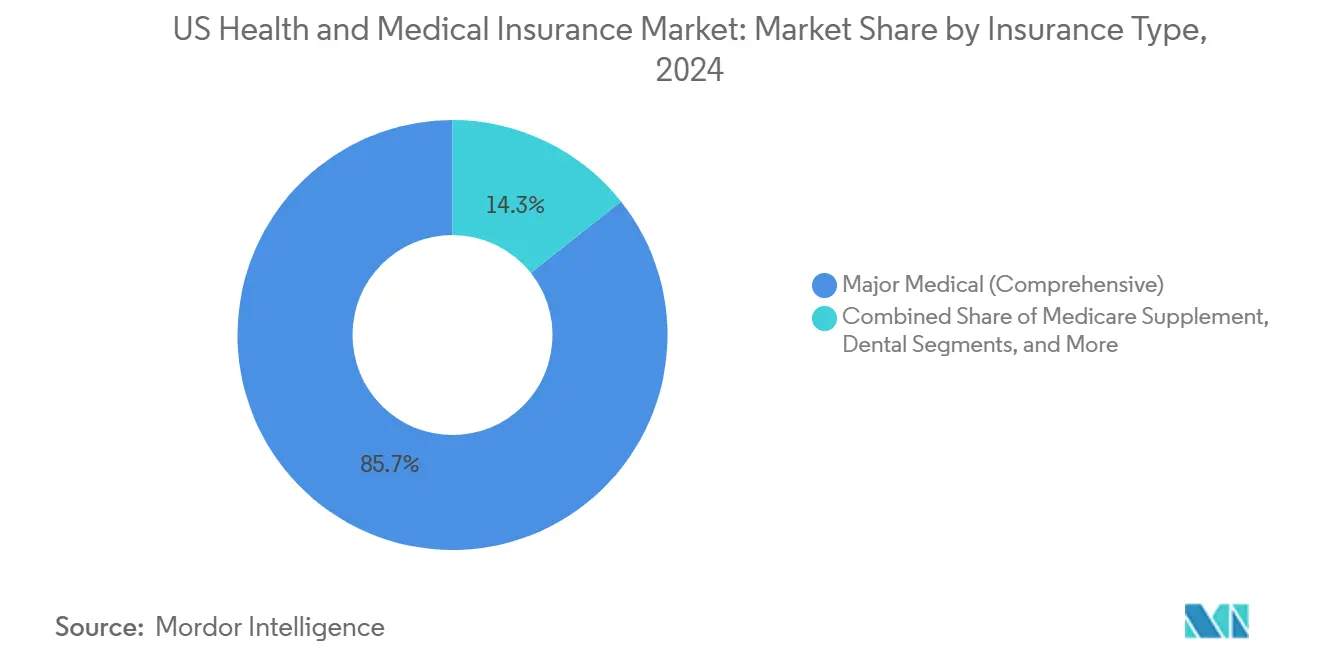
By Distribution Channel: Hybrid Advice Model Undergoes Digital Reinvention
Brokers and agents captured 55.24% of 2024 enrollments, retaining the largest conduit to the United States health and medical insurance market share because complex benefit arrays still require human guidance, especially for small employers and Medicare-eligible consumers. The traditional model now integrates cloud-based quoting platforms that auto-populate census data, compare compliant plan grids, and produce signature-ready applications within minutes, which frees agents for consultative tasks such as compliance reviews and claims-trend analysis. Regulatory scrutiny of broker compensation in Medicare Advantage pushes carriers toward flat-fee or tiered schedules tied to member-experience metrics instead of raw volume, increasing demand for seasoned advisors who can demonstrate retention and quality scores.
Online marketplaces and insurer-direct portals record a 12.00% CAGR, helped by mobile enrollment flows, real-time subsidy calculators, and API links to state eligibility systems that shorten onboarding to under 10 minutes for straightforward households. Younger adults and freelance workers prefer these channels for self-directed comparisons, while embedded insurance widgets inside payroll and gig economy apps introduce coverage offers at the point of income reception. Employer benefits consultants hold their niche within large groups by layering decision support analytics and captive pharmacy benefit management modules that quantify potential savings from network steerage. CMS's investment of USD 100 million in Navigator groups reinforces a hybrid model in which licensed experts guide consumers through digital interfaces, a design that boosts enrollment accuracy and reduces post-issue rescissions. Artificial intelligence chatbots and voice assistants now handle routine questions about deductibles and formulary tiers, which enables human agents to devote more time to high-value renewal strategy discussions.
Geography Analysis
The South’s 35.34% premium share anchors the United States health and medical insurance market, thanks to steady inbound migration, diversified industry growth, and gradual Medicaid expansion that enlarges low-income coverage pools. Marketplace enrollment surges in Florida and Georgia supplement employer penetration, while Medicare Advantage adoption widens as carriers tailor culturally competent networks. Rising hospital consolidation inflates cost indices yet provides economies of scale that insurers leverage in risk-based contracts.
The West showcases the fastest 6.40% CAGR on the strength of affluent technology clusters, innovative policy levers, and consumer affinity for digital enrollment solutions [3]Colorado Division of Insurance, “Public Option Premium Analysis 2025,” doi.colorado.gov. California’s state-run exchange refines outreach with multilingual apps, whereas Colorado’s option plus reinsurance tandem lowers premiums across the risk pool. High net migration into Nevada, Arizona, and Utah propels employer plan expansion and lifts average premiums. Still, provider-participation constraints in rural counties challenge network adequacy and raise administrative load for carriers.
The Northeast and Midwest retain balanced yet slower growth profiles. Northeastern carriers benefit from dense provider networks and elevated utilization that stabilizes revenue, but aging demographics cap expansion potential. Meanwhile, Midwestern states wrestle with manufacturing-sector shifts and population stagnation, dampening employer-sponsored premium growth. Nonetheless, robust collective-bargaining traditions help preserve comprehensive coverage, and star-rated Medicare Advantage plans secure loyalty among retirees seeking predictable benefits.
Competitive Landscape
UnitedHealth Group tops the United States health and medical insurance market, via its UnitedHealthcare insurance and Optum services ecosystem. Humana, Elevance Health, CVS Health/Aetna, and Kaiser Permanente round out the top tier, all investing heavily in technology, virtual care, and value-based provider alignment to contain cost and boost quality. Regional Blues such as Health Care Service Corporation leverage local market knowledge and scale through targeted acquisitions, exemplified by its USD 3.3 billion purchase of Cigna’s Medicare assets that added 600,000 members.
Competitive intensity is heightened by new entrants harnessing AI for plan design and care navigation, but strict capital and regulatory requirements limit disruptive scale. Strategic partnerships with primary-care groups and specialty pharmacies differentiate incumbents and foster vertically integrated models that can withstand medical inflation. Government oversight of prior-authorization algorithms and broker compensation tightens compliance obligations, driving carriers toward transparent consumer-experience improvements to sustain brand loyalty.
Payers ramp up M&A activities, aiming for member growth, risk diversification, and streamlined administrative costs. Elevance Health’s 2025 acquisition of Indiana University Health Plans highlights the strategic importance of localized provider integration. Meanwhile, CVS Health extends its community-clinic footprint to funnel medication-adherence programs into its Aetna plans, sharpening its competitive response to Optum’s growing ambulatory presence. The arms race for data analytics talent and cloud architecture underscores the sector’s pivot toward personalized underwriting and proactive care management.
United States Health And Medical Insurance Industry Leaders
-
UnitedHealth Group
-
CVS Health (Aetna)
-
Elevance Health (Blue Cross Blue Shield)
-
Cigna Group
-
Humana
- *Disclaimer: Major Players sorted in no particular order
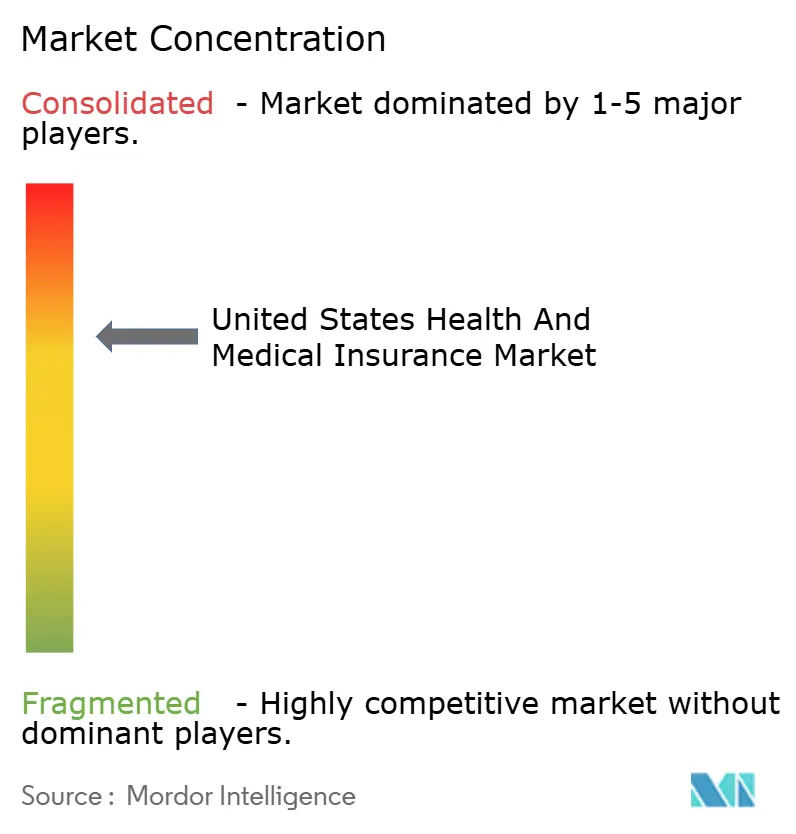
Recent Industry Developments
- January 2025: Health Care Service Corporation completed its USD 3.3 billion acquisition of Cigna’s Medicare business, adding almost 600,000 Medicare Advantage members.
- January 2025: Elevance Health finalized the purchase of Indiana University Health Plans, integrating 19,000 Medicare Advantage and 9,600 employer members.
- January 2025: CMS issued the final 2026 Notice of Benefit and Payment Parameters, boosting guardrails against unauthorized plan switches and setting 2.5% user fees for federal exchanges.
- December 2024: Congress extended Medicare telehealth flexibilities to Mar 2025, maintaining most geographic waivers.
Research Methodology Framework and Report Scope
Market Definitions and Key Coverage
Mordor Intelligence defines the United States health and medical insurance market as all written premiums, public or private, covering medically necessary services delivered inside the fifty states, the District of Columbia, and U.S. territories. Benefits considered include inpatient and outpatient care, prescription drugs, preventive services, long-term managed care, and supplemental gap products that attach to major medical plans.
Scope Exclusions: stand-alone discount cards, excepted benefit indemnity plans, and international travel policies are excluded from our sizing.
Segmentation Overview
- By Coverage Type
- Employer-Sponsored
- Individual (ACA / Non-Group)
- Medicaid Managed Care
- Medicare Advantage
- Military / Government (TRICARE, VA, FEHBP)
- By Plan Type
- HMO
- PPO
- EPO
- POS
- HDHP / Consumer-Driven
- By Insurance Type
- Major Medical (Comprehensive)
- Medicare Supplement
- Dental
- Hospital Indemnity / Limited Benefit
- Vision
- Short-Term Medical
- Other Ancillary (Accident, Critical Illness)
- By Distribution Channel
- Direct to Consumer
- Brokers & Agents
- Employer Benefit Consultants
- Online Marketplaces / Exchanges
- By Region
- Northeast
- Midwest
- South
- West
Detailed Research Methodology and Data Validation
Primary Research
Multiple semi-structured interviews with carrier actuaries, brokers, hospital finance leaders, and state regulators helped us pressure test loss ratio assumptions, enrollment elasticity, and average premium paths across regions. These conversations, spanning all four census regions, also verified early findings on Medicare Advantage penetration and employer contribution strategy shifts.
Desk Research
Analysts begin with authoritative public datasets such as CMS National Health Expenditure Accounts, NAIC statutory premium filings, U.S. Census Current Population Survey, and Bureau of Labor Statistics medical inflation indices. We enrich these baselines with insights from trade bodies like AHIP, Kaiser Family Foundation, and state insurance department dashboards, while corporate 10-Ks and investor decks clarify carrier level trends. Select paid repositories, notably D&B Hoovers for company revenue splits and Dow Jones Factiva for deal flow, fill remaining gaps. This source list is illustrative; numerous additional outlets were tapped for validation and nuance.
Market-Sizing & Forecasting
Our model starts with a top-down roll-up of premium collections by segment (employer, individual, Medicare Advantage, Medicaid managed care, military), adjusted to gross written terms. Selective bottom-up carrier sampling, premium and enrollment dashboards from the ten largest insurers, checks segment totals. Key variables driving the forecast include medical cost inflation, population aged 65 plus, Medicaid enrollment volumes, employer-sponsored coverage counts, and average deductible levels. Values feed a multivariate regression and scenario analysis framework that projects premiums through 2030 while accounting for policy changes and economic swings. Data voids, for instance, limited transparency in self-funded stop-loss rates, are bridged through benchmark ratios derived from primary interviews and CMS trend factors.
Data Validation & Update Cycle
Outputs undergo variance checks against CMS and NAIC time series, followed by peer review by a senior analyst team. Any anomaly above a three percent threshold triggers re-contact with domain experts. Reports refresh annually, and material events, large mergers, federal rule changes, and public health emergencies prompt interim model updates before client delivery.
Why Mordor's United States Health and Medical Insurance Baseline Commands Reliability
Published market estimates often diverge because firms pick different benefit scopes, enrollment bases, and premium definitions.
Key gap drivers include whether short-term and supplemental products are counted, how aggressively discounted ASPs are applied to Medicaid managed care, and the cadence at which data feeds are refreshed. Our analysts report a balanced base case tied to the most recent NAIC and CMS releases, whereas other publishers may adopt earlier snapshots or rely on untested carrier surveys.
Benchmark comparison
| Market Size | Anonymized source | Primary gap driver |
|---|---|---|
| USD 1.59 trillion (2025) | Mordor Intelligence | - |
| USD 1.54 trillion (2025) | Regional Consultancy A | Excludes Medicare Advantage premium flows |
| USD 1.23 trillion (2024) | Trade Journal B | Omits employer self-funded ASO equivalents and applies pre-2023 NAIC filings |
| USD 0.66 trillion (2025) | Industry Association C | Counts only individual ACA compliant and group risk business, ignoring government programs |
Taken together, the comparison shows that once scope, data timeliness, and premium definitions are equalized, Mordor's disciplined blend of public micro data and targeted bottom-up checks delivers a dependable, decision ready baseline.
Key Questions Answered in the Report
What is the current size of the United States health and medical insurance market?
The United States health and medical insurance market size stood at USD 1.57 trillion in 2025 and is forecast to reach USD 2.1 trillion by 2030.
Which coverage type is growing fastest?
Medicare Advantage is the fastest-expanding coverage line, advancing at a projected 7.8% CAGR through 2030 on the back of aging demographics and enhanced supplemental benefits.
How big is the employer-sponsored segment?
Employer plans held 47.5% of the United States health and medical insurance market share in 2024, continuing to anchor overall risk pools and premium volumes.
What factors most influence premium growth?
Premiums are primarily driven by rising medical costs, higher specialty-drug spend, and greater utilization among seniors, offset in part by ACA subsidies and value-based care adoption.
Why is the West region outperforming other areas?
The West enjoys a 6.4% CAGR because of strong technology-sector employment, higher household income, and state-level initiatives such as public option and reinsurance programs that lower premiums and boost enrollment.
How will broker roles change by 2030?
Brokers will remain critical for complex decision support but will rely increasingly on digital tools and AI-assisted quoting as online exchanges post a 12% CAGR and consumer expectations for seamless enrollment rise.
Page last updated on:
